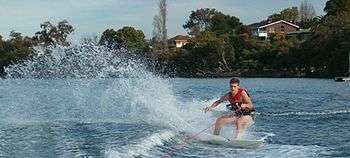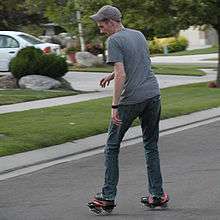Skurfing (sport)
Skurfing as a sport has two common uses: "water skurfing" and "street skurfing".
Water Skurfing

Water Skurfing is a form of water skiing that uses a surfboard or similar board instead of skis. The skurfer is towed behind a motorboat at planing speed with a tow rope similar to that of Knee Boarding and wakeboarding. It shares an advantage with kneeboarding in that the motorboat does not require as much speed as it does for water skiing.[1]
Skurfing is a towsport and it is very similar to water skiing. The skurfboard, however, is a surfboard and is usually shorter by about two feet, wider and has three larger fins that make the board easier to manoeuvre while being pulled behind a boat. The planing speed of the motorboat is equivalent to the speed generated by a wave and allows the skurfer to ride behind the boat the same way a surfer would ride a wave. One of the advantages of skurfing when compared with surfing is that when the water is flat, skurfing is still possible. Skurfing can be done behind a boat or a jet ski on a river or in an ocean. The manoeuvres on a skurfboard are similar to those on a surfboard, these include.
- cut-backs
- 180
- 360
- aerial jumps
- power slides
- freeriding
Freeriding is when the wake is surfed without the rope. First the rider pulls themselves up the rope so that they are skurfing in the largest part of the wake. The rider then gently pumps the board to maintain speed and moves their weight further forward to help them stay on the wake wave. Once they are being propelled by the wake the rope is thrown back into the boat.
Skurfing has developed into its own unique sport but has also been used in adapting other sports such as surfing. Before skurfing was invented there were limitations to paddling onto larger waves when surfing because surfers lacked the speed needed to stay in front of the wave. Skurfing has shown the world the potential of big wave surfing by towing the surfer towards big waves. Therefore giving the surfer the speed needed to catch the wave successfully.
The early usage was a portmanteau of skiing (as in water skiing) and surfing, and was used to describe a popular surface water sport in which the participant is towed on a surfboard behind a boat with a ski rope.
Although the "Skurfer" (a branded water-sport product) was originally trademarked by a surfer named Tony Finn in the mid 1980s, the word 'Skurfing' was potentially first coined in New Zealand by surfboard shaper Allan Byrne. Allan Byrne lent a surfboard to Jeff Darby and friends in Queensland Australia who started to make their own and later came in contact with Tony Finn who was to later produce the brand Skurfer' under royalty.
Many years prior to Tony Finn and the 'Skurfer', Australian surfboard shaper and inventor Bruce McKee along with associate Mitchell Ross, launched the world's first mass-produced plastic roto-moulded construction 'Skurfboard' named the 'Mcski', later renamed 'SSS' skiboard and then 'Wake-snake' in Australia. The board had adjustable rubber foot-straps, concave tunnel bottom and a keel fin. Two smaller side fins were later added for greater hold and more maneuverability.
Bruce McKee and associate Mitchell Ross negotiated with USA's Medalist Waterskis and the first American production was launched. The launch of the product's American version being named the 'Surf-Ski' was in 1984 at Chicagos 'IMTEC' show. At the show McKee also met Tony Finn who was the proposed Californian representative. Tony Finn, went on to do his own negotiations with Darby and company from Australia and the result as mentioned above were the US boards later launched under the 'Skurfer' brand name.
Surfing is highly popular in the state of Western Australia and in many other places in the world. Unlike most other water sports where the participant is towed, water skurfing is not a professional sport and has no official competitions. It is a freestyle sport with highly individualistic style and form. There are no defined styles or conventions, rather it is about personal style.
Water Skurfing is considered by many to be a precursor to wakeboarding, as the skurfboards evolved in the late 1980s into compression-moulded products (aka "skiboards") then eventually into the twin-tipped Wakeboard.
Styles
There are two main styles of water skurfing, the noseriding style, mostly used by people who surf on a longboard. The alternative is with cutbacks, carves and other turns. Some skurfers even get air over the wake.
A new style of water skurfing has recently emerged in the sport where the fins are removed from the bottom of the board. This finless style requires more balance and finesse than having the fins attached. Not having fins limits cutbacks and carving, but allows the rider to spin the board around in a 360-degree rotation.
Street Skurfing

This usage is a portmanteau of Skateboarding and Surfing. See also Freeline skates.
Street Skurfing is the melding of many elements of skateboarding with the technical and practically applicable skills gained from slalom, downhill, or any other side-sport disciplines such as surfing, snowboarding, skateboarding, and casterboarding. It focuses heavily on spins, slides, "stance" changes, and carving. There are no set rules, tricks, or techniques except the heavy emphasis of a fluid and surf-like execution through a course. The usually adopted terrain is a mix of steep grade roads, driveways, concrete banks, and ditches.
Styles
There are two types of styles for street skurfing. The first style involves a single board (often a skateboard or custom-cut deck). The second style is actually a common term used for caster skating. It involves two separated boards or skates instead of a single skateboard. One of the advantages of having separated skates is that the rider can maneuver with both feet individually. In addition, Street Skurfing involves making much tighter turns, s-shape motions, and even travelling up and down hills.
See Also
References
- ↑ "Great Tips On How To Skurf". Street Directory. Retrieved 29 April 2016.